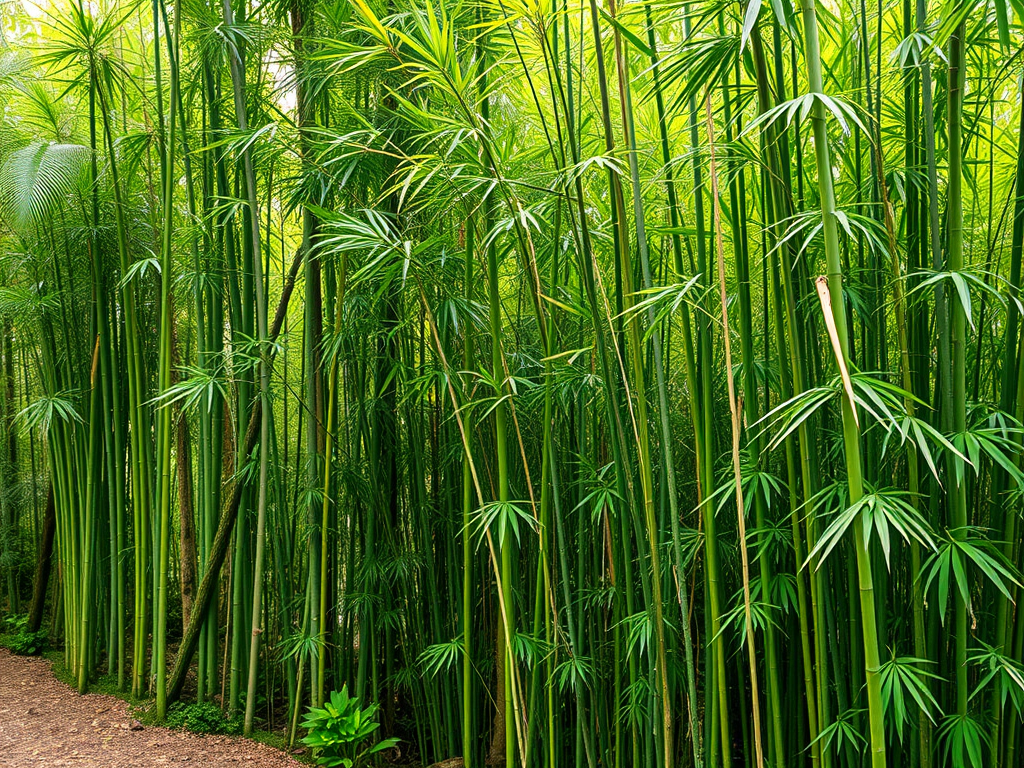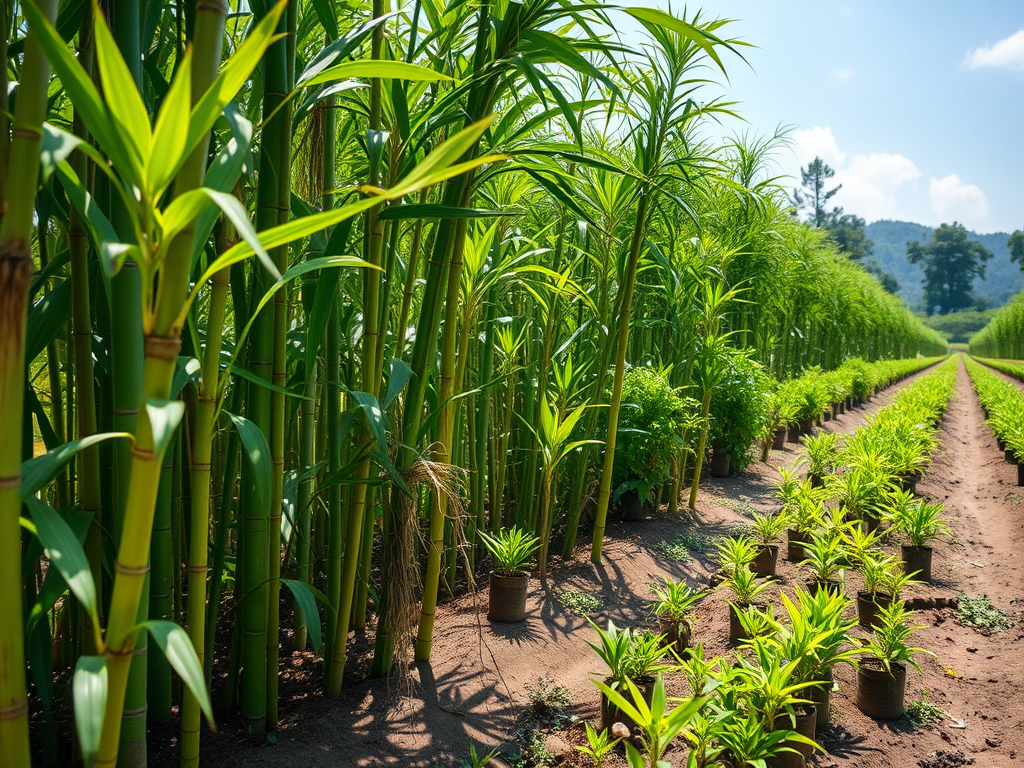
Introduction: Bamboo Cultivation in Northeast India: Northeast India, with its lush landscapes and rich biodiversity, is a bamboo haven. Known as “green gold,” bamboo drives economic, cultural, and ecological benefits. From livelihoods to environmental restoration, its cultivation shapes the region’s sustainable future, rooted in tradition and innovation.
Ecological Fit: Northeast India’s subtropical climate creates an exceptional environment for bamboo cultivation, characterized by high humidity (70-90%), warm temperatures ranging from 20-30°C, and substantial annual rainfall of 1,000 – 4,000 mm. These conditions, coupled with well-drained, fertile loamy soils rich in organic matter, provide optimal growth for bamboo, enabling it to flourish across diverse terrains. The region is a biodiversity hotspot, hosting over 50% of India’s 136 bamboo species, including commercially significant ones like Bambusa tulda, Bambusa balcooa, and Dendrocalamus strictus. Bamboo’s remarkable adaptability allows it to thrive on degraded, marginal lands—such as abandoned fields or eroded hillsides—where other crops often fail. Its extensive, fibrous root system anchors soil, effectively preventing erosion on the region’s steep, rain-soaked slopes, which are prone to landslides during monsoons. With some species growing up to 30 cm daily, bamboo rapidly restores degraded ecosystems, stabilizes landscapes, and supports sustainable land management, making it a vital ecological asset for Northeast India’s environmental resilience.
Economic Impact: Bamboo, known as “green gold,” is a vital economic driver in Northeast India. It supports diverse livelihoods through construction (housing, scaffolding), handicrafts (baskets, mats), and edible shoots for culinary markets. Farmers earn ₹75,000-80,000 per hectare annually, with high-demand species like Bambusa balcooa fetching premium prices. The National Bamboo Mission (NBM), launched in 2018, bolsters this sector by providing subsidies for plantation, training, and market linkages. Over 1.5 lakh farmers benefit from NBM’s support, with micro-enterprises producing bamboo furniture and agarbatti sticks adding value. Export potential, especially to Southeast Asia, is growing, with the region contributing 65% of India’s bamboo output, generating employment for rural youth and women.
Cultural Significance: Bamboo is intricately woven into the cultural tapestry of Northeast India, serving as a symbol of tradition, identity, and community. In Assam, artisans skillfully craft japi hats, conical headgear adorned with intricate bamboo designs, worn during festivals and agricultural ceremonies. Bamboo also features prominently in the vibrant Bihu festival, where it is used to create decorative props and traditional musical instruments like the gogona, a bamboo reed instrument. In Arunachal Pradesh, tribal communities rely on bamboo to fashion tumblers for serving apong, a fermented rice beer central to rituals and social gatherings, showcasing the material’s role in preserving indigenous customs. Across the region, bamboo bridges and houses reflect architectural ingenuity, blending functionality with cultural aesthetics. Culinary traditions also embrace bamboo, with tender edible shoots being a delicacy in dishes like Manipur’s eromba or Nagaland’s fermented shoot pickles, adding unique flavors to local cuisines. From festivals to daily life, bamboo remains a cornerstone of Northeast India’s rich cultural heritage, connecting generations through its versatile uses.

Sustainable Practices: Bamboo cultivation in Northeast India is a model of eco-friendly agriculture, leveraging the region’s natural resources for sustainability. Farmers utilize rainwater harvesting and drip irrigation to minimize water use, capitalizing on the region’s high rainfall (1,000-4,000 mm annually). Intercropping is widely practiced, with shade-loving crops like turmeric, ginger, and black pepper grown alongside bamboo to diversify income and optimize land use. This approach not only boosts farmers’ earnings by 20-30% but also enhances soil fertility through crop rotation. Bamboo’s vegetative propagation, using culm cuttings or rhizomes, ensures low-maintenance cultivation, as it requires minimal replanting and can regenerate for decades. Organic farming methods dominate, with farmers using natural compost and avoiding chemical fertilizers, preserving the region’s ecological balance. These practices align with traditional knowledge, making bamboo farming both cost-effective and environmentally sustainable, while supporting smallholder farmers in achieving long-term economic stability.
Environmental Benefits: Bamboo is a powerhouse for environmental conservation, offering significant ecological advantages. Its rapid growth and dense root system make it an exceptional tool for carbon sequestration, absorbing up to 12 tons of CO2 per hectare annually, outpacing many tree species. Bamboo produces 35% more oxygen than equivalent tree cover, improving air quality in the region’s densely vegetated landscapes. Its extensive fibrous roots stabilize soil, reducing erosion on Northeast India’s hilly slopes, which are vulnerable to heavy monsoon rains. By regenerating degraded lands, bamboo aids in land restoration, transforming barren or overworked fields into productive ecosystems. Additionally, it acts as a natural barrier against floods and landslides, enhancing climate resilience. Bamboo’s ability to grow without chemical inputs further reduces environmental impact, making it a cornerstone of sustainable land management and a critical ally in combating climate change in Northeast India.
Challenges & Future: Despite its potential, bamboo cultivation in Northeast India faces significant hurdles, primarily due to inadequate infrastructure and market access. Limited processing units restrict value addition, with only 10% of bamboo being processed into high-value products like furniture or textiles. Poor transportation networks in remote areas hinder market reach, while a lack of standardized quality control affects export competitiveness. Skilled labor shortages and outdated technology further slow industrial growth. However, the National Bamboo Mission (NBM) is addressing these challenges by investing in modern processing facilities,
training programs, and market linkages. The NBM aims to establish bamboo clusters, integrating farmers, artisans, and entrepreneurs to strengthen the value chain. By 2030, the mission targets self-sufficiency in bamboo products, reducing reliance on imports and boosting exports. Innovations in bamboo-based bioenergy, composites, and eco-friendly packaging are also gaining traction, promising a sustainable future where Northeast India leads as a global bamboo hub.
Conclusion: Bamboo cultivation in Northeast India is a beacon of sustainability, blending economic prosperity, cultural heritage, and environmental stewardship. From empowering farmers to preserving traditions and combating climate change, bamboo’s versatility shines. Despite challenges like limited processing, initiatives like the National Bamboo Mission pave the way for growth. As “green gold,” bamboo holds the promise of transforming the region into a global hub, fostering resilience and harmony with nature.
